“Economic advantages may be created by any person who surrounds himself with the advice, counsel, and personal cooperation of a group of men who are willing to lend him wholehearted aid, in a spirit of PERFECT HARMONY. This form of cooperative alliance has been the basis of nearly every great fortune. Your understanding of this great truth may definitely determine your financial status.” – p195
“No two minds ever come together without, thereby, creating a third, invisible, intangible force which may be likened to a third mind. … The human mind is a form of energy, a part of it being spiritual in nature. When the minds of two people are coordinated in a SPIRIT OF HARMONY, the spiritual units of energy of each mind form an affinity, which constitutes the “psychic” phase of the Master Mind.” – p195
“Power, as the term is here used, refers to ORGANIZED effort, sufficient to enable an individual to transmute DESIRE into its monetary equivalent. ORGANIZED effort is produced through the coordination of effort of two or more people, who work toward a DEFINITE end, in a spirit of harmony.” – p193
“The list of the chief sources from which POWER may be attained is, as you have seen, headed by INFINITE INTELLIGENCE. When two or more people coordinate in a spirit of HARMONY, and work toward a definite objective, they place themselves in position, through that alliance, to absorb power directly from the great universal storehouse of Infinite Intelligence. This is the greatest of all sources of POWER. It is the source to which the genius turns. It is the source to which every great leader turns, (whether he may be conscious of the fact or not).” – Chapter 10. Power of the Master Mind: the Driving Force, THINK AND GROW RICH (Napoleon Hill, 1937), p199
“Two people who collaborate well will be about three times as effective as each of them operating independently, because each will see what the other might miss—plus they can leverage each other’s strengths while holding each other accountable to higher standards.” – a. 1+1=3, 4.5. Great collaboration feels like playing jazz, Chapter 4. Get and Stay in Sync, Part III. Work Principles, PRINCIPLES (Ray Dalio, 2017), p368
Contents
- The Master Mind Group as Power
- Why ‘In Spiritual Harmony?’ – Scientific Understanding of Mind Is Needed
- Real Cases Where the Master Mind Principle Was Successfully Harnessed
- Characteristics of the Master Mind Group
- Leadership Implication
- Business Implications: What Are the Benefits?
- Closing

In my previous article ([6] – Values, Abilities and Skills: What Comes First in Deciding the Right People for Your Firm?), I have discussed why shared value and character traits are considered more important than ability and skills in choosing the ‘right’ people, quoting cases by Jim Collins and Ray Dalio.
There’s another dimension we can consider to understand why choosing the ‘right people’ matters, which I found significant and might be of interest to readers for practical application.
As a leader, how do you achieve your goal once you set it? How do you drive the whole journey until you attain the ultimate outcome? What’s your power – a driving force – that can push yourself persistently without distraction? Are you harnessing your people to reach your destination together effectively? Or are you a charismatic ‘genius’ with thousand helpers?
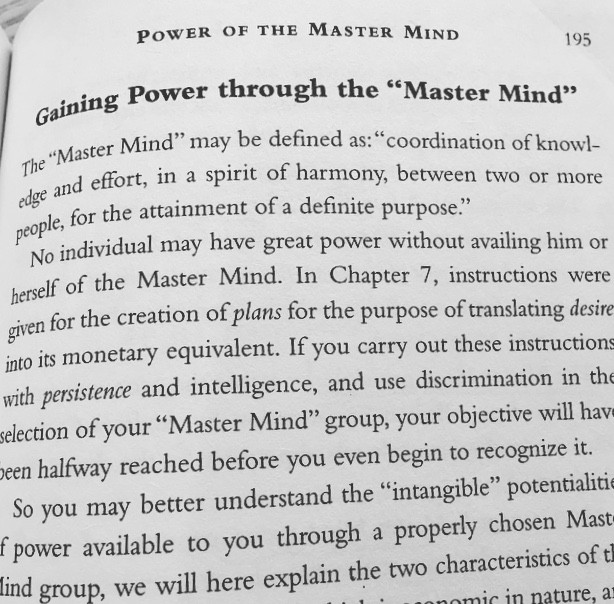
The Master Mind Group as Power
In Think and Grow Rich, Hill stresses that we need ‘power’ to transmute desire into its monetary equivalent in both accumulation and retention, for it is power – defined as ‘organized effort‘ – that transmutes plans into action. 1
And he states that ORGANIZED effort is produced through the coordination of effort of two or more people, who work toward a DEFINITE end, in a spirit of harmony.
People who possessed this form of power – cooperative alliance or cooperation of a group of men – are said to have been greatly benefited in attaining their desire in an economic sense. 2
Quoting Andrew Carnegie’s case as an example, Hill introduces a concept of the Master Mind (Principle) or the Master Mind Group with the following definition: People who are coordinated with a spirit of harmony to work toward a definite purpose. 3
Hill might have used the term, the Master Mind, simply to describe a powerful mechanism in achieving a monetary goal, but I have, upon contemplation, learned that its power potentially bears much more significance when applied in various life or business situations beyond just a monetary implication.
I would like to suggest that behind most of the great achievements – be they great fortunes or great business successes – exist a powerful group of people in the form of the Master Mind Group.
In fact, if we look around, we can easily find that examples abound both throughout history and in our time. Also, we can observe that business leaders, consciously or unconsciously, acknowledge the importance of the principle by having, by their side, “the right people” who share value and definite purpose and by utilizing this powerful system for their success.
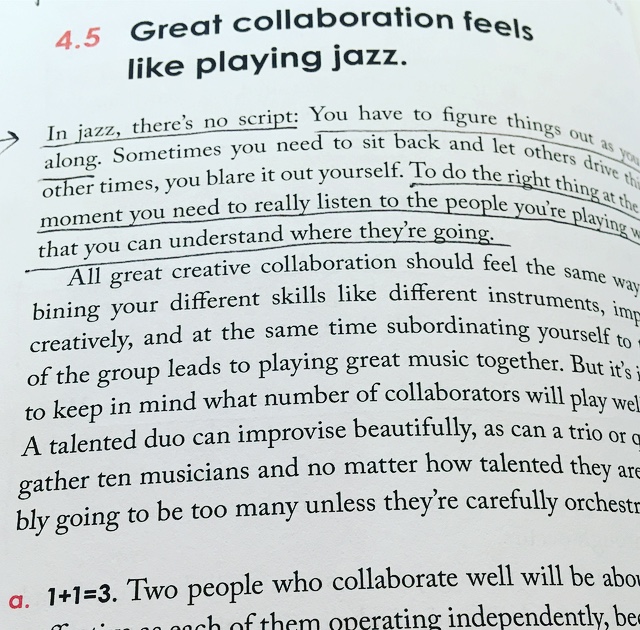
Why ‘In Spiritual Harmony?’ – Scientific Understanding of Mind Is Needed
To understand why and how the Master Mind works, it’s essential that we first understand how our mind works in Hill’s terms – mind as energy.
You might recall my first two articles of the Mind series, where I have discussed our thoughts as energy ([1] – What’s Your Level of Energy? And of Your Thought?), and introduced one of powerful workings of our thoughts – amplification of its force ([2] – What Is the Quality of a Lucky Person?: Understanding Two Powerful Aspects of Thought). I have shared an insight that thought as a force attracts the reciprocated minds and amplifies it, regardless of its nature – negative or positive.
Hill shares the same perspective: Human brain is like a radio station sending and receiving signals to/from other brains. Mind reciprocates by sending and receiving certain frequencies just like energy. 4 The term ‘to get in sync’ implies this aspect of human mind.
This leads us to a clear insight on the power of the Master Mind as an Aligned Mind: Whereas minds well aligned and/or synced intensify their thought forces in a consistent and productive manner, minds that are not aligned on shared mission or definite purpose or common values in a group, will end up as a simple collection of a crowd – a distracted and weak force.
Dalio’s discussion below is noteworthy in this context:
“There are all kinds of different people in the world, many of whom value different kinds of things. If you find you can’t get in sync with someone on shared values, you should consider whether that person is worth keeping in your life. A lack of common values will lead to a lot of pain and other harmful consequences and may ultimately drive you apart. It might be better to head all that off as soon as you see it coming.”
– 4.7. If you can’t reconcile major differences – especially in values – consider whether the relationship is worth preserving, Chapter 4. Get and Stay in Sync, Part III. Work Principles, PRINCIPLES (Ray Dalio 2017), p369
“The person who is capable but doesn’t have good character is generally destructive, because he or she has the cleverness to do you harm and will certainly erode the culture. In my opinion, most organizations overvalue the abilities piece and undervalue the character piece because of a shortsighted focus on getting the job done. In doing so, they lose the power of the great relationships that will take them through both good and bad times.”
– 8.4.f. Make sure your people have character and are capable, Chapter 8. Hire Right, Because the Penalties for Hiring Wrong Are Huge, Part III. Work Principles, PRINCIPLES (Ray Dalio 2017), p415
Being in spiritual harmony means being aligned – in sync – on the same mission and value.
Once this alignment is set up, moving on with harmony becomes an easier track because shared values and character traits would build the solid foundation of trust. The Master Mind group glued on this principle – spiritual harmony, that is – would create a powerful synergy effect.
We have seen this powerful working of aligned minds from the level 5 executive members of good-to-great companies who forged ahead together in difficult times. For them, fierce debates, arguments and numerous challenges they had to go through to build the best and the great company in the world were simply passing hurdles.
I believe, as a leader, employing the Master Mind principle will create an effect similar to adding fuels in driving our vehicle. By forming the Master Mind, one attains a powerful driving force.
Can we also see other vivid examples of the Master Mind?
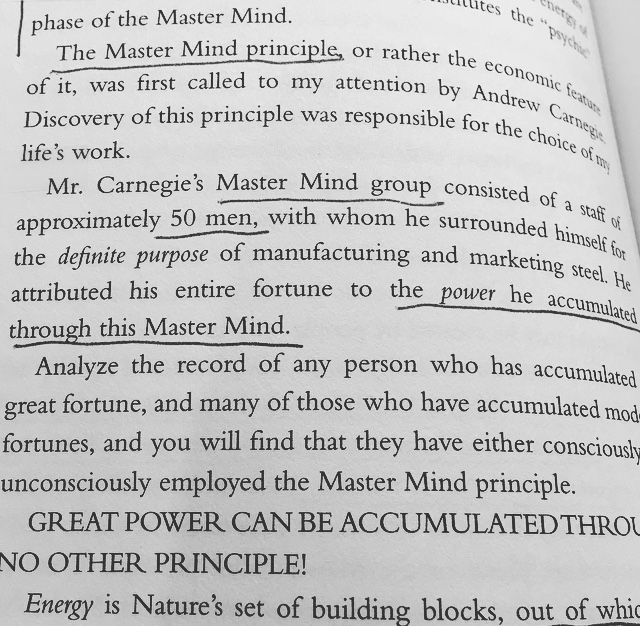
Real Cases Where the Master Mind Principle Was Successfully Harnessed
As I said, examples abound throughout history. A few cases illustrate how the principle was successfully harnessed.
1. Andrew Carnegie (1835-1919) and a staff of fifty men
Mr. Carnegie’s Master Mind group consisted of a staff of approximately fifty men, with whom he surrounded himself, for the DEFINITE PURPOSE of manufacturing and marketing steel. He attributed his entire fortune to the POWER he accumulated through this “Master Mind.” 5
2. Henry Ford (1863-1947) and four men
Henry Ford whipped poverty, illiteracy, and ignorance by allying himself with great minds, whose vibrations of thought he absorbed into his own mind. Through his association with Edison, Burbank, Burroughs, and Firestone, Mr. Ford added to his own brain power, the sum and substance of the intelligence, experience, knowledge, and spiritual forces of these four men. Hill reiterates: “Men take on the nature and the habits and the POWER OF THOUGHT of those with whom they associate in a spirit of sympathy and harmony.” 6
3. Declaration of Independence (American Revolution 1765-1783) and fifty-six men
The United States of America was born of a DECISION created by a Master Mind, consisting of fifty-six men. When Thomas Jefferson finished reading the Declaration of Independence before the Congress on July 4, 1776, the document was voted upon, accepted and signed by the 56 men, everyone staking his own life upon his decision to write his name.
It was their DECISION which insured the success of Washington’s armies, because the spirit of that decision was in the heart of every soldier who fought with him, and served as a spiritual power which recognizes no such thing as FAILURE. 7
4. Level 5 executive team members of Good-to-Great companies in the late twentieth century (1970-2001)
As we’ve observed numerous cases from the previous article ([5] – It’s Who!: People and Their Spirit! [A Management Case]), the good-to-great CEOs (Level 5 leaders), instead of being at the center of power and glory, chose to surround themselves with the right group of people based upon the ‘Who First’ principle.
Even if the term of the Master Mind was not used in Good to Great, I believe the Level 5 leaders knew, consciously or unconsciously, how powerful collective minds can be. Just as Andrew Carnegie did, they harnessed the Master Mind Principle by surrounding themselves with the advice, counsel, and personal cooperation of a group of men who are willing to lend him wholehearted aid, in a spirit of PERFECT HARMONY.
Being extremely humble yet ambitious, it is clear that the Level 5 leaders(CEOs) used the executive team members as a powerful driving force in reaching their goals – to build a great company from mere mediocrity.
A few illustrations may help to gain a clearer view of how exactly they did.
CEOs of Fannie Mae, Walgreens and Wells Fargo, for example, once onboard, focused first on getting the right people on their management team, building one of the most talented or the best executive teams.
Nucor, Pitney Bowes, Kimberly-Clark, and Philip Morris maintained rigorous cultures with people who shared strong work ethics or the company’s mission. They kept the best people and executives as team members (the right people) who argued and debated yet unified fully behind a decision.
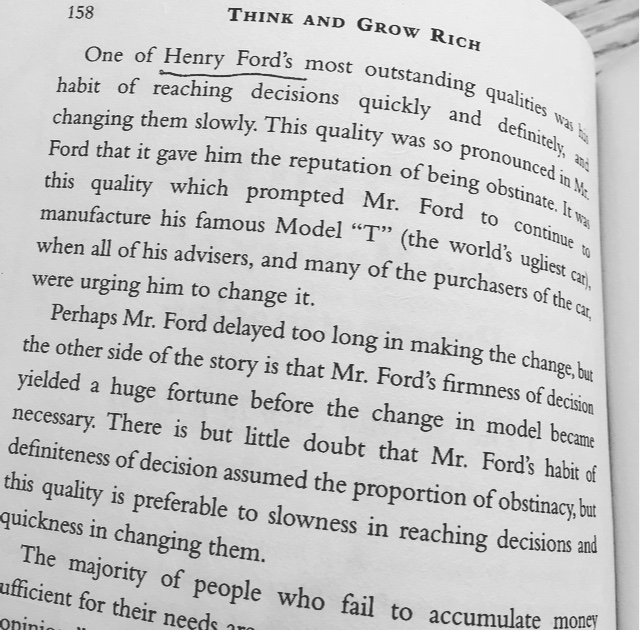
Characteristics of the Master Mind Group
Above cases are only a few examples but we certainly had a glimpse of what the Master Mind is. Moving on a bit further, we would like to see what powerful qualities these Master Minds did demonstrate.
1. Definiteness of Decision
First of all, when we look at the case of the Declaration of Independence, it’s evident that they made a clear and definite decision, backed by the spirit of faith. And this is the power that gave America its freedom.
The ability to make a decision is power, because it’s extremely difficult when vested interests and stakes are high. Hill states that this ability to reach a definite decision is a key quality needed in leadership. 8 When you build a top management team who are not necessarily on the same wavelength, how can you imagine you can reach the definite decision making?
2. Unwavering Faith, Persistence, and Organized Planning
The definiteness of decision is only possible when the minds are seeking the common mission based on the shared value. This definite mission enables them to hold unwavering faith, then again to become persistent through organized planning and efforts until they achieve goals. When you are surrounded by people who can motivate you to drive consistently, the journey to the ultimate destination gets easier than when you are alone.
When we look at the Master Minds of the good-to-great companies, all these qualities are clearly shown. With definite purpose and mission based on shared values, those right people – ‘Who’ – never backed off even in times of conflict until they reached a high point of success and achievement.
And of course we can imagine the same traits must have been shared among the Master Minds of industrial magnets such as Andrew Carnegie let alone Henry Ford.
Leadership Implication
When you, as CEO or an owner of a business, decide to start a challenging journey toward a definite goal, how would you like to proceed? You have two choices. You can stand at the top of the hierarchy with a clear vision having thousand helpers with you. You can stand at the center of the wheel and become a focal point of drive. You yourself become power.
Or, you decide to build a powerful group of the Master Mind and surround yourself with it. You are not at the center of the wheel. Your role, as a humble yet extremely driven CEO, is to have the right people planted at the right place steer the boat harmoniously together. They and you together become a focal point of drive. When you leave, however, the wheel doesn’t stop because they as power still work at the center.
In a journey to greatness, simply being good is the enemy, says Collins. A traditional approach of hiring a celebrity CEO from outside, who ultimately may succeed to build a great company while on board, carries a potential pitfall of sliding back to mediocrity in case of his/her absence. How can we prevent this from happening to build a greatness that lasts for generations?
The answer seems clear. Have a great group – the Master Mind – near you and have them continue to build a great company even in the absence of a CEO. They are the people who are aligned not only with the company’s core values but also with each other. They are the ultimate driving force who would stay there and wouldn’t stop forging ahead in adversity simply to make the company great, let alone themselves. They also enjoy each other and create great life together, while on their journey of creating a great company.
Business Implications: What Are the Benefits?
In addition to the key qualities mentioned above, I see more benefits from the Master Mind.
They are Creativity in terms of original ideas, vision, and problem solving; Self-motivation; and a Culture fostering a great life.
1. Creativity required for vision, original ideas and problem solving
Hill defined power as ‘organized knowledge.’ According to him, knowledge is attained from mainly three sources: Infinite Intelligence, accumulated experience and experiment and research. The knowledge acquired then is converted into power by organizing it into definite plans and by expressing those plans in terms of action. 9
TTo have power we need to have organized knowledge. Then it is evident that attaining knowledge from the source – either from the Infinite Intelligence, or accumulated experience or experiment and research- is a critical matter.
When two or more people in a spiritual harmony cooperate, they put themselves in a ‘better’ position to directly tune into Infinite Intelligence, accessing original creative ideas that translate into vision, strategy, and problem solving. I am certain that this is the most powerful benefit that can be gained from the Master Mind and that any business can harness. “Focused minds can create powerful avenue to directly access to Infinite Intelligence, and this is the source to which the genius turns and every great leader turns, consciously or unconsciously.” 10
For Level 5 leaders, ‘people’ question comes first and foremost. Once the right people are onboard, then they will work on where to go – setting vision and strategy and solving problems. When we have a powerful group of people who are aligned on core values and mission, it is clear that we have a definite advantage in developing original and creative ideas crucial for business success. It’s the focused minds that enable it.
2. Motivation (Self-motivation)
When you are surrounded by a Master Mind and by the cooperative efforts of the members of the group, you can develop persistence and motivation which you can easily lose when you pursue your goals alone.
As we’ve seen from good-to-great management team members, the right group of people – self-disciplined leaders as they are – are also self-motivated. Their power of persistence and self-motivation, backed by unwavering faith demonstrates that, even in the challenging time of facing the brutal facts of reality, they get stronger and resilient instead of being weaker and dispirited. Their self-motivated spirit sees to it that they will find a way to prevail even if it will be a long journey. 11
Here we have a powerful leadership implication. Collins comments that “Spending time and energy trying to “motivate” people is a waste of effort. … If you have the right people, they will be self-motivated.” 12
3. A Culture Shaped by Great People Sharing Great Life
It turned out that people who were members of the good-to-great teams (the Master Mind Group) tended to become and remain friends for life. These minds who went through the dark days in their journey to make a mediocre business into a great one enjoyed each other’s company and actually looked forward to meetings. These people had fun! 13
“Adherence to the idea of “first who” might be the closest link between a great company and a great life. For no matter what we achieve, if we don’t spend the vast majority of our time with people we love and respect, we cannot possibly have a great life. But if we spend the vast majority of our time with people we love and respect – people we really enjoy being on the bus with and who will never disappoint us – then we will almost certainly have a great life, no matter where the bus goes. The people we interviewed from the good-to-great companies clearly loved what they did, largely because they loved who they did it with.” – First Who, Great Companies, and a Great Life, Chapter 3. First Who … Then What, GOOD TO GREAT (Jim Collins, 2001), p62
They had a great life because they had mutual respect and trust that they would never disappoint each other.
Here we see why it matters to be in a spiritual harmony. It creates a great culture where great people thrive and enjoy their life together.
There is another great example why this is true. I made a glimpse of this truth through Ray Dalio’s Principles.
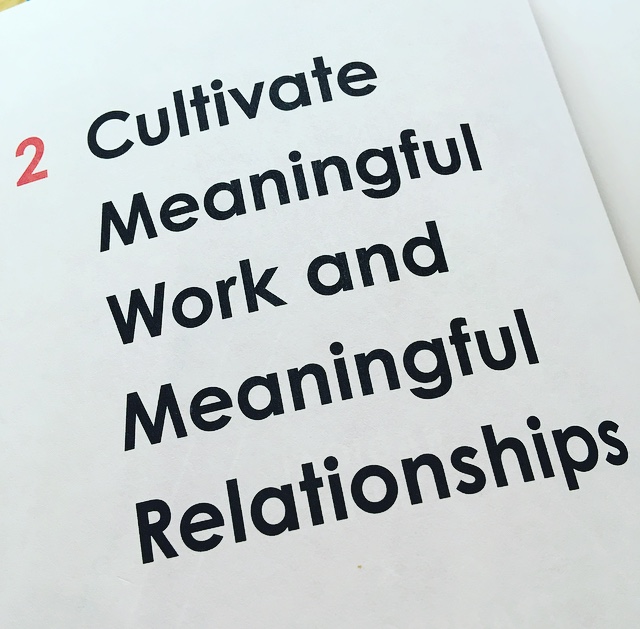
“Meaningful relationships are invaluable for building and sustaining a culture of excellence, because they create the trust and support that people need to push each other to do great things. If the overwhelming majority of people care about having an excellent community, they will take care of it, which will yield both better work and better relationships. Relationships have to be genuine, not forced; at the same time, the culture of the community will have a big influence on how people value relationships and how they behave with each other. To me, a meaningful relationship is one in which people care enough about each other to be there whenever someone needs support and they enjoy each other’s company so much that they can have great times together both inside and outside of work.”
– Chapter 2. Cultivate Meaningful Work and Meaningful Relationships, Part III. Work Principles, PRINCIPLES (Ray Dalio, 2017), p339
“Remember that for an organization to be effective, the people who make it up must be aligned on many levels – from what their shared mission is, to how they will treat each other, to a more practical picture of who will do what when to achieve their goals. Yet alignment can never be taken for granted because people are wired so differently. We all see ourselves and the world in our own unique ways, so deciding what’s true and what to do about it takes constant work.”
– Chapter 4. Get and Stay in Sync, Part III. Work Principles, PRINCIPLES (Ray Dalio, 2017), p357
“Turnover is costly and inefficient because of the time it takes for people to get to know each other and the organization. Both the people you work with and the company itself will evolve in ways you can’t anticipate. So hire the kind of people you want to share a long-term mission with. You will always have uses for great people. … You need people who share your tastes and style but who can push and challenge each other. The best teams whether in music, in sports, or in business, do all those things at the same time.”
– 8.5. Don’t hire people just to fit the first job they will do; hire people you want to share your life with, Chapter 8. Hire Right, Because the Penalties for Hiring Wrong Are Huge, Part III. Work Principles, PRINCIPLES (Ray Dalio, 2017), p415
“While there is nobody in the world who will share your point of view on everything, there are people who will share your most important values and the ways in which you choose to live them out. Make sure you end up with those people.”
– 4.6. When you have alignment, cherish it, Chapter 4. Get and Stay in Sync, Part III. Work Principles, PRINCIPLES (Ray Dalio, 2017), p369
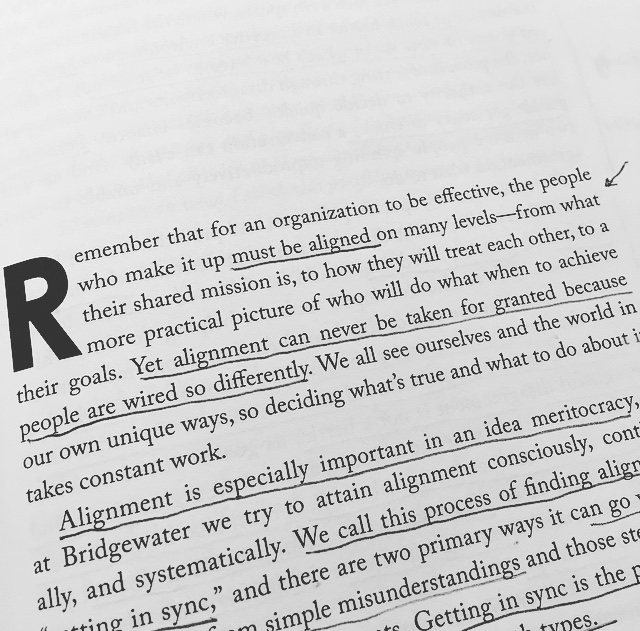
Closing
I have tried to explore a little bit further on what the Master Mind can do and how we can create value by harnessing this principle.
Seeking people for business or for any endeavor implies more than simply adding one or a few head-count.
In my opinion, it helps to acknowledge the unseen yet powerful force working behind in regards to ‘people’ question.
People are minds. I believe that understanding the spiritual workings of human mind as an energy form – an insight powerful enough and never to be dismissed – will provide a leader with a depth in dealing with people question.
Besides, we have much to gain from the Master Mind principle both for personal endeavors and business efforts. If you are a leader, the simple insight of the Master Mind principle can lend you a powerful tool in forging ahead and ultimately achieve greatness in your business success.
What’s your thought on this subject? How do you want to harness the principle for yourself and your business? I urge you to contemplate on this subject often.
Jay
“New technology tends to come from new ventures – startups. From the Founding Fathers in politics to the Royal Society in science to Fairchild Semiconductor’s “traitorous eight” in business, small groups of people bound together by a sense of mission have changed the world for the better.” 14
– Peter Thiel
References:
GOOD TO GREAT (Jim Collins 2001)
PRINCIPLES (Ray Dalio 2017)
THINK AND GROW RICH (Napoleon Hill 1937)
ZERO TO ONE (Peter Thiel 2014)
Quotes:
- (p193), Chapter 10. Power of the Master Mind: the Driving Force, THINK AND GROW RICH
- (p195), Ibid
- (p195), Ibid
- (p239) Chapter 13. The Brain: A Broadcasting and Receiving Station for Thought, THINK AND GROW RICH
- (p195), Chapter 10. Power of the Master Mind: the Driving Force, THINK AND GROW RICH
- (p198), Ibid
- (p169), Chapter 8. Decision: the Mastery of Procrastination, THINK AND GROW RICH
- (p170), Ibid
- (p194), Chapter 10. Power of the Master Mind: the Driving Force, THINK AND GROW RICH
- (p194), Ibid
- (p74), A Climate Where the Truth Is Heard, Chapter 4. Confront the Brutal Facts (Yet Never Lose Faith), GOOD TO GREAT
- (p89), Summary, Chapter 4. Confront the Brutal Facts (Yet Never Lose Faith), GOOD TO GREAT
- (p62), First Who, Great Companies, and a Great Life, Chapter 3. First Who … Then What, GOOD TO GREAT
- (p10), Chapter 1. The Challenge of the Future, ZERO TO ONE

